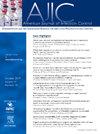血流感染:基于机器学习模型(BLISCO)的可靠多维预后评分的推导与验证。
IF 3.8
3区 医学
Q2 INFECTIOUS DISEASES
引用次数: 0
摘要
背景:目前尚无适用于血培养采集时的血流感染(BSI)预后评分:目前尚无适用于血培养采集时的血流感染(BSI)预后评分:方法:纳入 4327 名 BSI 患者,分为推导数据集(80%)和验证数据集(20%)。分析了从电子病历中提取的与宿主相关的、人口统计学、流行病学、临床、实验室等 42 个变量。在对多个机器学习模型进行测试后,选择逻辑回归进行预测评分。使用灵敏度、特异性和预测值评估了准确性:14天死亡率模型包括年龄、体温、血尿素氮、呼吸功能不全、血小板计数、高敏C反应蛋白和意识状态:得分≥6与14天死亡率15%相关,灵敏度为0.742,特异性为0.727,AUC为0.783。30 天死亡率模型还包括心血管疾病:得分≥ 6 可预测 15%的 30 天死亡率,灵敏度为 0.691,特异度为 0.699,AUC 为 0.697:快速、易于评估的死亡率评分可有效支持对未入住重症监护室的 BSI 患者进行预后评估和资源优先排序。本文章由计算机程序翻译,如有差异,请以英文原文为准。
Bloodstream infection: Derivation and validation of a reliable and multidimensional prognostic score based on a machine learning model (BLISCO)
Background
A bloodstream infection (BSI) prognostic score applicable at the time of blood culture collection is missing.
Methods
In total, 4,327 patients with BSIs were included, divided into a derivation (80%) and a validation dataset (20%). Forty-two variables among host-related, demographic, epidemiological, clinical, and laboratory extracted from the electronic health records were analyzed. Logistic regression was chosen for predictive scoring.
Results
The 14-day mortality model included age, body temperature, blood urea nitrogen, respiratory insufficiency, platelet count, high-sensitive C-reactive protein, and consciousness status: a score of ≥ 6 was correlated to a 14-day mortality rate of 15% with a sensitivity of 0.742, a specificity of 0.727, and an area under the curve of 0.783. The 30-day mortality model further included cardiovascular diseases: a score of ≥ 6 predicting 30-day mortality rate of 15% with a sensitivity of 0.691, a specificity of 0.699, and an area under the curve of 0.697.
Conclusions
A quick mortality score could represent a valid support for prognosis assessment and resources prioritizing for patients with BSIs not admitted in the intensive care unit.
求助全文
通过发布文献求助,成功后即可免费获取论文全文。
去求助
来源期刊
CiteScore
7.40
自引率
4.10%
发文量
479
审稿时长
24 days
期刊介绍:
AJIC covers key topics and issues in infection control and epidemiology. Infection control professionals, including physicians, nurses, and epidemiologists, rely on AJIC for peer-reviewed articles covering clinical topics as well as original research. As the official publication of the Association for Professionals in Infection Control and Epidemiology (APIC)

 求助内容:
求助内容: 应助结果提醒方式:
应助结果提醒方式:


